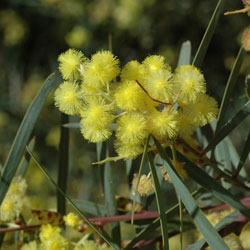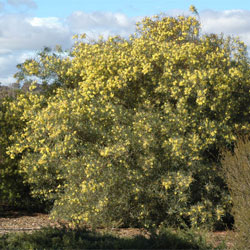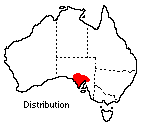Acacia iteaphylla
 |
 |
Willow-leaved Wattle, Flinders Range Wattle
Acacia iteaphylla F.Muell. ex Benth.
Acacia iteaphylla occurs naturally in South Australia extending from the Flinders Ranges across to the Gawler Ranges and the Eyre Peninsula. Commonly called Willow-leaf Wattle, this shapely decorative shrub is hardy and fast growing and flowers intermittently throughout the year with a peak flowering period in spring. It is versatile in its habit growing to a height of 2-4 m with some forms becoming upright, whilst others are pendulous and bushy. Several specimens which are thriving in the Australian National Botanic Gardens are upright and multi-stemmed from ground level.
 Many
species of Acacia bear phyllodes rather than leaves. A phyllode is defined as
a leaf whose blade is much reduced or absent, and whose petiole and rachis have assumed the functions of the whole leaf. The slender phyllodes
of A. iteaphylla are from 50 -100 mm long and are broadly linear with
a small gland at the base. They are blue-green in colour and arranged alternately,
almost at right angles to the stems. The perfumed flower heads are produced
in clusters of pale yellow balls which contrast pleasingly with the foliage.
The buds are attractively enclosed by conspicuous pale, brown-tipped bracts.
The flowers are followed by masses of flattened blue-green seed pods which become
brown when mature.
Many
species of Acacia bear phyllodes rather than leaves. A phyllode is defined as
a leaf whose blade is much reduced or absent, and whose petiole and rachis have assumed the functions of the whole leaf. The slender phyllodes
of A. iteaphylla are from 50 -100 mm long and are broadly linear with
a small gland at the base. They are blue-green in colour and arranged alternately,
almost at right angles to the stems. The perfumed flower heads are produced
in clusters of pale yellow balls which contrast pleasingly with the foliage.
The buds are attractively enclosed by conspicuous pale, brown-tipped bracts.
The flowers are followed by masses of flattened blue-green seed pods which become
brown when mature.
A low growing form of A. iteaphylla has been recognised. It differs from other known forms in having low arching, slightly pendulous branches and grows to 0.5 m high by 4 m across. This plant, which originated as a variant in a batch of seedlings, has been registered as the cultivar Acacia 'Parsons Cascade'. To retain its low spreading growth habit the cultivar should be propagated only from cuttings as it will not necessarily breed true from seed.
Acacia iteaphylla grows best in a well drained sunny position. It is moderately frost tolerant and moderately salt tolerant. It can be propagated from cuttings taken between February and April. A rooting hormone has been effectively used at the Australian National Botanic Gardens. Seed germinates readily but should be scarified or treated with boiling water before sowing.
Light pruning throughout the development of the plant will keep it vigorous and encourage bushiness. An application of a complete fertiliser in spring and a slow release fertiliser in autumn is also recommended. Pests noted on A. iteaphylla are the acacia bug, which rasps the leaf tissue causing brown lesions to appear on leaves and stems, and scale insects. Chemical control of acacia bug is difficult as the insect is usually no longer present when the damage is noticed. Affected parts of the plant should be pruned out. Scale insects may be controlled by chemical means but low toxicity products should be selected. Consult a local horticultural specialist for advice.
Text by Effie Mullins, ANBG (1989)
Name meaning: Acacia iteaphyllaAcacia - may be from the Greek 'to sharpen', referring to the prickly nature of the first species discovered; another opinion refers to the Egyptian thorn (akakia), a species of Acacia which yields gum arabic; iteaphylla - from two Greek words meaning willow-leaved. |
![An Australian Government Initiative [logo]](/images/austgovt_brown_90px.gif)

